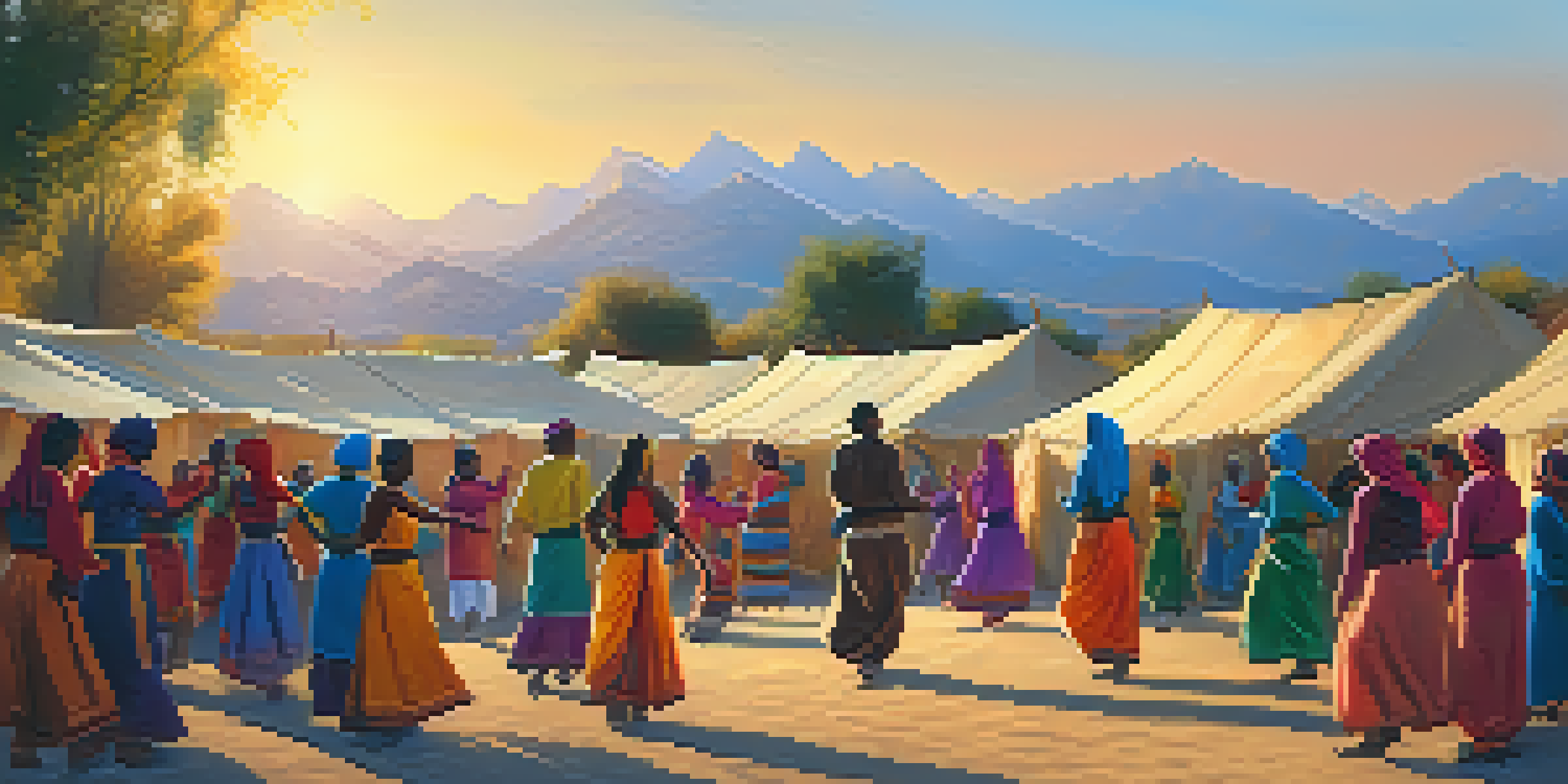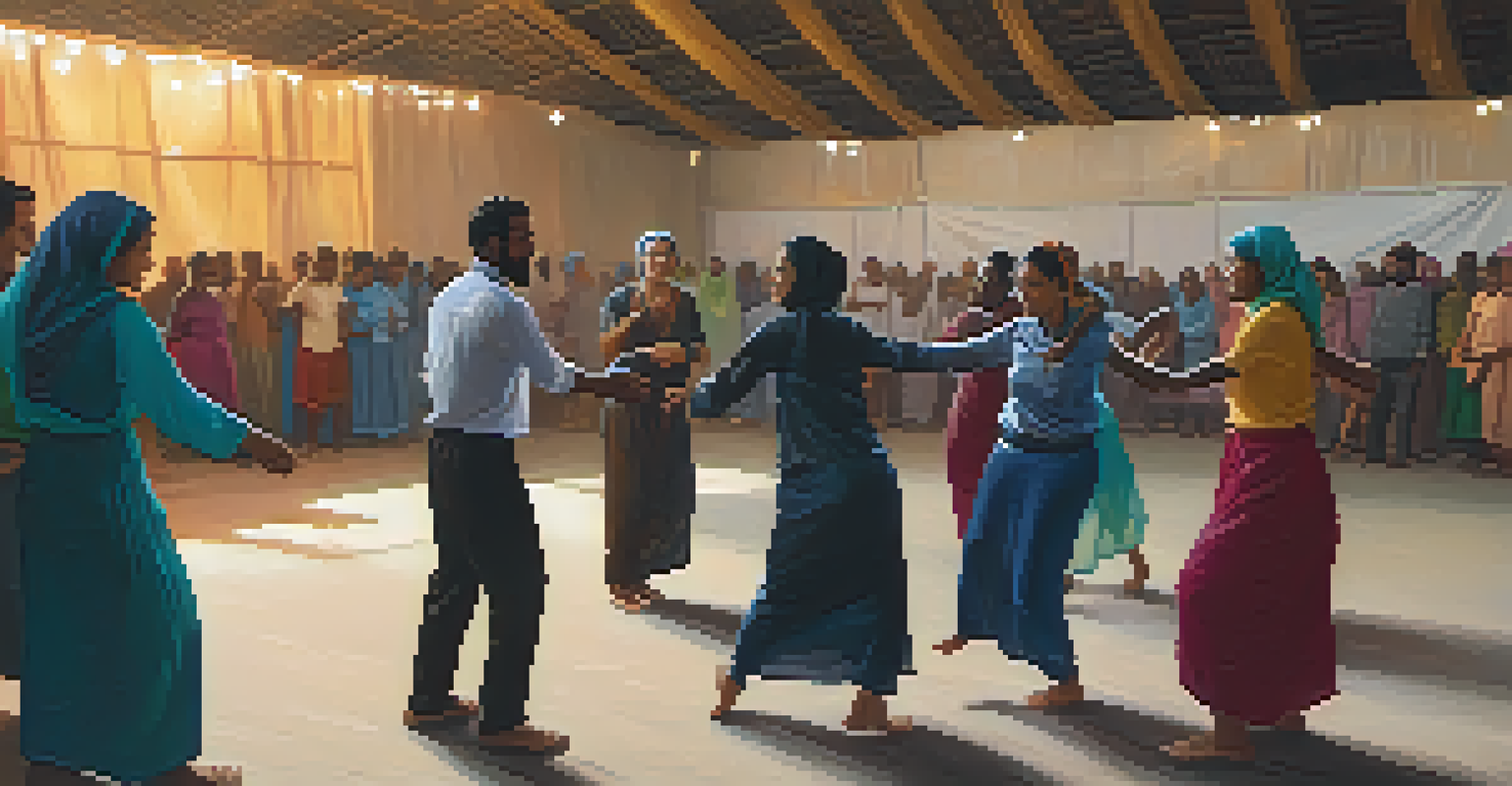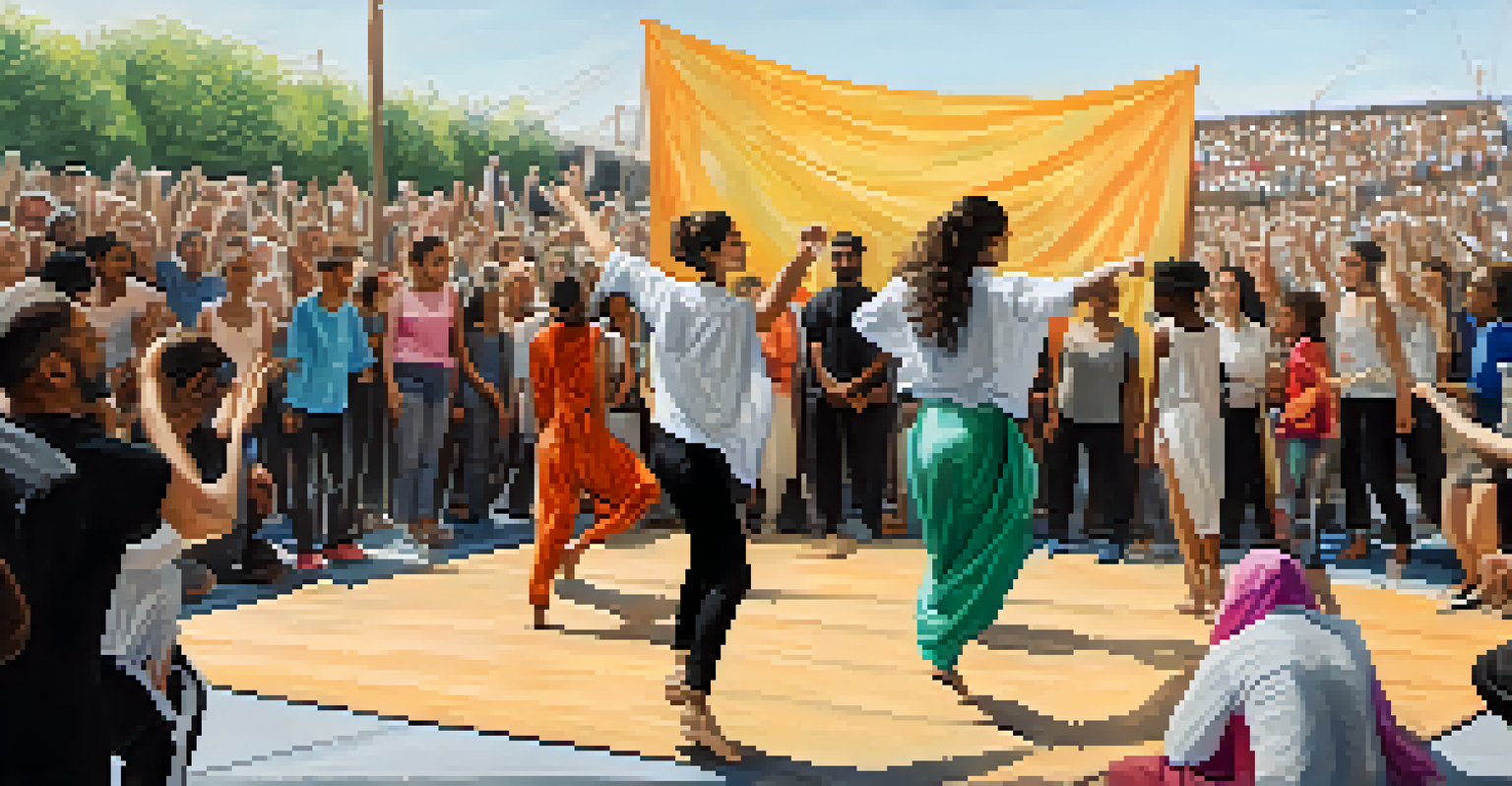Cultural Expressions: Dance in Refugee Crisis Responses

The Role of Dance in Refugee Communities
Dance serves as a vital cultural expression for refugees, providing a sense of identity and continuity amidst displacement. In many cultures, dance is deeply woven into social fabric, allowing individuals to reconnect with their roots. This connection fosters a sense of belonging, which is crucial for those navigating the challenges of resettlement.
Dance is the hidden language of the soul.
For instance, traditional folk dances performed in refugee camps can bring people together, creating a shared space for joy and expression. These gatherings not only celebrate cultural heritage but also enhance emotional well-being, offering an escape from the harsh realities of life in exile. It’s a reminder that even in the toughest times, community and culture can flourish.
Additionally, dance can serve as a powerful medium for storytelling, helping refugees share their experiences with others. Through movement, they can convey emotions and narratives that words sometimes fail to express. This aspect highlights the transformative power of dance in fostering understanding and empathy among diverse audiences.
Healing Through Movement: Dance Therapy
Dance therapy has emerged as an effective tool for healing among refugees, addressing both physical and psychological trauma. This therapeutic approach encourages individuals to express their feelings through movement, facilitating emotional release and healing. Such practices can be especially beneficial for those who have experienced significant loss or violence.

For example, workshops incorporating dance therapy have been implemented in refugee camps, where participants engage in guided movement sessions. These activities not only help reduce symptoms of anxiety and depression but also promote resilience and coping strategies. The shared experience of movement fosters a sense of community, creating bonds among participants.
Dance as Cultural Identity
Dance serves as a vital cultural expression for refugees, fostering a sense of identity and belonging amidst displacement.
Moreover, dance therapy can assist in rebuilding self-esteem and confidence, allowing individuals to reclaim their bodies and agency. By engaging in dance, refugees can experience a sense of control over their own lives, which is often stripped away in crisis situations. This empowerment is transformative, enabling them to envision a hopeful future.
Dance as a Tool for Advocacy and Awareness
Dance can play a crucial role in raising awareness about the plight of refugees and advocating for their rights. Through performances and dance initiatives, artists can shine a light on the struggles faced by displaced individuals, fostering greater understanding among wider audiences. These artistic expressions can challenge stereotypes and humanize the refugee experience.
Movement is a medicine for creating change in a person's physical, emotional, and mental states.
For instance, dance companies have collaborated with refugee communities to create performances that tell their stories. By showcasing these narratives on stage, they draw attention to the resilience and strength of refugees, shifting the public narrative from one of victimhood to empowerment. This approach not only educates audiences but also inspires action.
Additionally, dance festivals and events can serve as platforms for refugees to share their talents and cultures. Such events promote solidarity and raise funds for humanitarian efforts, creating a ripple effect of support and compassion. This intersection of art and activism exemplifies how dance can be a powerful ally in the fight for social justice.
Cultural Preservation Through Dance
In the face of displacement, dance becomes a means of cultural preservation for refugees. Traditional dances often carry historical significance, embodying the narratives of communities and their struggles. Maintaining these practices helps preserve a sense of identity, even when individuals are far from their homeland.
Workshops that focus on traditional dance forms allow refugees to pass down their cultural heritage to younger generations. This transmission of knowledge not only strengthens community bonds but also instills a sense of pride in one’s identity. It fosters intergenerational connections, bridging the gap between old and new experiences.
Dance Therapy for Healing
Dance therapy effectively addresses physical and psychological trauma among refugees, promoting emotional release and resilience.
Moreover, cultural exchanges through dance can enrich host communities, promoting diversity and mutual understanding. As refugees share their dances, they invite others to engage with their culture, creating opportunities for dialogue and collaboration. This exchange highlights the importance of inclusivity and respect for diverse identities.
Dance as a Form of Protest and Resistance
Throughout history, dance has been employed as a powerful form of protest and resistance, especially in the context of refugee crises. Movements that incorporate dance challenge oppressive systems and advocate for change. Through their bodies, dancers can express dissent and call for justice, making their voices heard in a unique way.
For example, flash mob performances in urban spaces can highlight the urgency of refugee issues, drawing public attention to their plight. These spontaneous displays of art convey a strong message, encouraging community engagement and action. Such forms of protest can be deeply impactful, resonating with audiences on an emotional level.
Furthermore, choreographed pieces that address themes of displacement and resilience can inspire solidarity among diverse groups. By uniting people through the language of dance, these performances cultivate empathy and encourage collective action. Dance becomes a channel for voices that might otherwise remain unheard.
Collaboration Between Artists and Refugees
Collaborative projects between artists and refugee communities can yield powerful outcomes, blending creativity with social impact. These partnerships often result in innovative performances that reflect the lived experiences of refugees, fostering mutual understanding and respect. Such collaborations can break down barriers and challenge preconceived notions about displacement.
For instance, dance workshops led by professional artists provide refugees with opportunities to explore their creativity and express their stories. These safe spaces for artistic exploration can be incredibly empowering, allowing individuals to reclaim their narratives. The resulting performances often resonate deeply with audiences, creating connections across cultures.
Advocacy Through Dance
Dance acts as a powerful tool for advocacy, raising awareness about refugee struggles and inspiring social change through artistic expression.
Moreover, these collaborations can lead to the establishment of supportive networks that extend beyond the art world. By working together, artists and refugees can advocate for systemic change, using their collective voices to address the challenges faced by displaced individuals. This unity can amplify their impact and foster long-term relationships.
The Future of Dance in Refugee Contexts
As the world continues to grapple with ongoing refugee crises, the role of dance will likely become even more significant. The arts have the power to transcend borders and unite people, making dance an essential tool for healing, advocacy, and cultural expression. Looking forward, more initiatives that integrate dance into refugee support systems are needed.
Innovative programs that leverage technology, such as online dance classes and virtual performances, can provide refugees with opportunities to connect and express themselves. These platforms can bridge geographical gaps, fostering a sense of community and belonging, no matter where individuals find themselves. The digital age presents exciting possibilities for artistic collaboration.

Ultimately, the future of dance in refugee contexts holds the potential for greater empowerment and resilience. By embracing dance as a vital form of expression, we can support refugees in reclaiming their identities and advocating for their rights. This commitment to cultural expression can pave the way for a more inclusive and compassionate world.